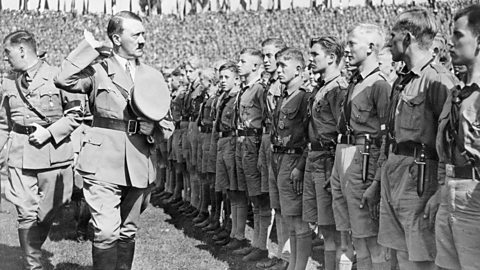How did Hitler change Germany from a democracy to a Nazi dictatorship?
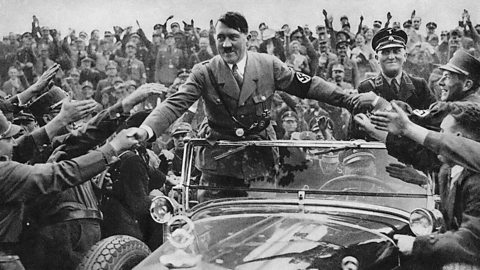
In January 1933, Adolf Hitler became ChancellorThe leader in the Reichstag, appointed by the German President. of Germany.
He led the right-wing Nationalist Socialist German Workers Party (NSDAP or Nazi Party).
It had received 33% of the vote in the ReichstagThe German Parliament. elections in November 1932.
This, plus the support of the President, Paul von Hindenburg, was sufficient to make him Chancellor, but did not give him complete control of Germany.
During the next 18 months, Hitler eliminated nearly all sources of opposition, both within the Nazi Party and in Germany.
By August 1934, he had declared himself №уГјіу°щ±р°щ - the sole leader of Germany.
The Reichstag Fire

In January 1933, the majority of the seats in the ReichstagThe German Parliament. belonged to Hitler’s rivals.
This was a problem because he needed to gain control of two-thirds of the seats in order to change the constitutionRules by which a country is organised and governed. to enable him to create a dictatorship A country ruled by someone who has complete authority..
He therefore convinced President Hindenburg to call a new Reichstag election for March 1933.
However, on 27 February 1933, a few days before the election, the Reichstag building was set on fire.
A Dutch communist, Marinus van der Lubbe, was caught in the burning parliament.
Hitler therefore used the fire as an excuse to persuade President Hindenburg that there was a communistSomeone who believes in the political ideology of communism, a system of running a country in which all means of production such as tools, factories and raw materials, are owned by the community as a whole. Private property does not exist and each individual contributes according to their ability and receives according to their needs. This means there is no hierarchy of social class. plot to overthrow the government.

The Law for the Protection of People and State
As a direct result of the Reichstag fire, the President, to whom the constitutionRules by which a country is organised and governed. had given a decreeAn official order equivalent to a law. in an emergency, approved the Law for the Protection of People and State.
The Law for the Protection of People and State was an important step in Hitler becoming a dictator.
It removed many people’s civil rights Rights everyone is entitled to regardless of the colour of their skin, their beliefs, sexuality, sex or other personal characteristics. These rights could include - amongst other things - the right to vote, the right to free speech or the right to a good education..
The key terms were:
- The removal of freedom of speech.
- The introduction of state censorship.
- The removal of personal freedom.
- The removal of a right to free assembly.
Question
How did the Law for the Protection of the People and State help Hitler?
Hitler used the law to disrupt the election campaigns of his main rivals.
For example, he put many Communist Party (KPD) leaders in prison, confiscated their literature, closed their offices and used the SturmabteilungA group within the Nazi Party, also known as Stormtroopers, who wore military uniforms and marched through the streets. They were very violent and often attacked political opponents, such as communists, in the street. to break-up their meetings.
The Reichstag election, 5 March 1933
On 5 March 1933, a few days after the fire, the election took place. However, despite their advantages, the Nazis still did not gain the majority of seats that they needed.
The March 1933 Reichstag election results
| Party | Seats |
|---|---|
| The Nazi Party | 288 Seats |
| Social Democrats | 120 seats |
| The Communist Party | 81 seats |
| The Centre Party | 74 seats |
| DNVP (Nationalist Party) | 52 seats |
Overall, 44% of the German people voted for the Nazis.
Question
Why did the Nazis still not have enough votes with 288 seats?
Although the Nazis won 288 seats, this was still not the two-thirds majority Hitler needed to control the Reichstag.
Hitler took the decision to form an alliance with one of the smaller parties - The Nationalist Party.
This alliance gave Hitler more than half of the seats, and as such, a stronger position in the Reichstag.
The Enabling Act
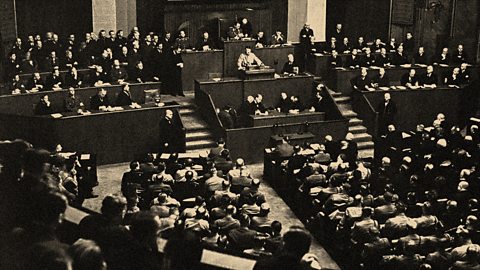
When the Reichstag met on 23 March 1933, Hitler was able to secure the passing of an important law, the Enabling Act.
He did this by:
- Banning the Communist Party and arresting other opposition party members using the The Law for the Protection of People and State.
- Persuading the Nationalist Party to support him in the Reichstag.
- Doing a deal with the Centre Party by promising to protect the rights of Catholics.
- Using SturmabteilungA group within the Nazi Party, also known as Stormtroopers, who wore military uniforms and marched through the streets. They were very violent and often attacked political opponents, such as communists, in the street. intimidation and violence against other parties.
Therefore, on the 23 March 1933, the Enabling Act was passed by the Reichstag by 441 votes to 94.
Question
Why was the Enabling Act so significant?
Arguably the most critical event during this period, the Enabling Act gave Hitler absolute power to make laws without the Reichstag’s approval for the next four years.
It enabled him to destroy all opposition to his rule.
It removed the Reichstag as a source of opposition and essentially made Hitler a dictatorA ruler with total power over a country, who has generally come into power through force. Dictators usually rule in a cruel and brutal way..
Within months of the passing of the Enabling Act, Hitler had removed most sources of political opposition.
Gleichschaltung
Gleichschaltung meant the co-ordination of all aspects of life - political, social and cultural - to fit in with Nazi ideas.
Hitler extended his power over key organisations either by taking them over, abolishing them, or doing a deal with them.
- March 1933: State parliaments closed down and re-established with Nazi majorities.
- April 1933: Jews and political opponents removed from jobs in the civil service and legal profession.
- May 1933: Trade unions banned.
- July 1933: All opposition parties were banned.
- January 1934: Law for the Reconstruction of the State abolished all state governments apart from Prussia’s.
These changes made Germany a one-party state and destroyed democracyA form of government in which people choose their leaders by voting. in the country.
The threat from Röhm and the SA
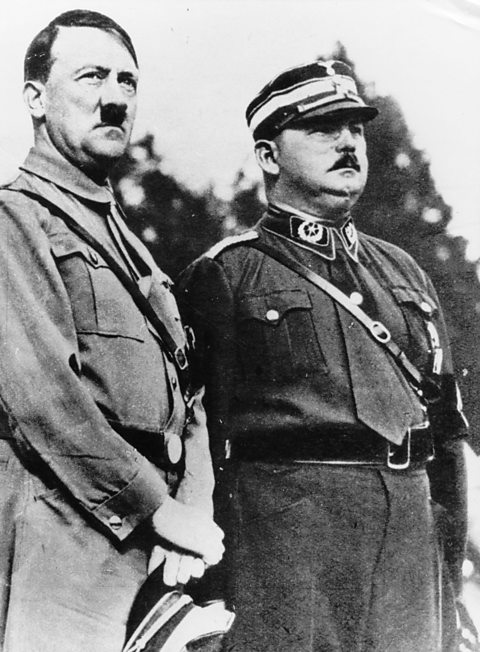
The SturmabteilungA group within the Nazi Party, also known as Stormtroopers, who wore military uniforms and marched through the streets. They were very violent and often attacked political opponents, such as communists, in the street. was the military wing of the Nazi Party and its leader was Ernst Röhm.
The SA had been very important in getting Hitler into power in January 1933 and in securing the Enabling Act in March 1933, but by 1934 Hitler wanted to get rid of this organisation.
Hitler had a number of reasons for wanting to eliminate the SA:
- It wanted to merge the German army under their control.
- It had become something of an embarrassment due to thuggish behaviour.
- It had two million members under Röhm by 1933.
- It had too many left wing ideas and talked of a second revolution which would give the SA more control over Germany.

The Night of the Long Knives, June 1934
Despite the SA’s plans, Hitler could not afford to lose the support of the German army.
It was the only remaining group which could challenge the Nazis and so, on 30 June 1934, Hitler ordered the SSThe Schutzstaffel, also known as the Blackshirts. A police/military style organisation created to serve as Hitler’s personal bodyguard. In Hitler's Germany they eventually controlled the intelligence, security and police forces, and the extermination of those they considered undesirable. (Hitler's personal bodyguards) to murder approximately 400 people, including Röhm.
They were mostly SturmabteilungA group within the Nazi Party, also known as Stormtroopers, who wore military uniforms and marched through the streets. They were very violent and often attacked political opponents, such as communists, in the street.leaders but also included a number of other opponents that Hitler wanted to eliminate, like Kurt von Schleicher, the last Chancellor before Hitler’s appointment.
In public, Hitler justified the slaughter by accusing the SA of being homosexuals and plotting against Germany.
On 3 July 1934, the Reichstag passed a law retrospectively legalising The Night of the Long Knives.
The Night of the Long Knives was very significant because:
- It destroyed all opposition to Hitler within the Nazi Party.
- It served as a warning to all Nazi opponents, discouraging potential opponents as they knew they would be dealt with ruthlessly.
- As a result, the Army publicly declared support for Hitler’s actions - grateful to him for removing the SA as a threat.
- It gave more power to the brutal SS, which became more important than the Nazi Party in running the dictatorship.
- It discouraged potential opponents because they knew they would be dealt with ruthlessly.
The death of President Hindenburg and Hitler becomes №уГјіу°щ±р°щ
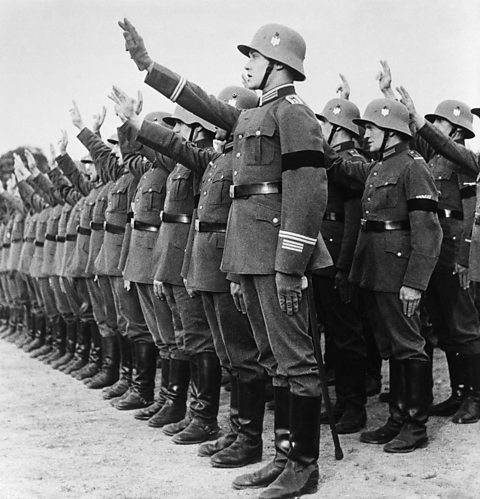
When President Hindenburg died on 2 August 1934, Hitler did not hold an election to replace him.
Instead, he declared himself President, Chancellor and Head of the Army and became known as the №уГјіу°щ±р°щ (leader).
Following Hindenburg's death and in return for the elimination of Rohm and the SA, the army generals agreed to swear an oath of allegiance to the new №уГјіу°щ±р°щ.
On 20 August 1934, all soldiers in the German army agreed to “unconditional obedience” to Hitler.
The German people subsequently approved of Hitler’s actions in a plebisciteA vote of the people on a particular question..
Therefore, by August 1934, Hitler had absolute power over Germany - he had created a totalitarian state A country ruled by someone who has complete authority. with one party and one leader.

Timeline: Hitler takes political control 1933-1934
Test your knowledge
More on Life in Nazi Germany, 1933-45
Find out more by working through a topic
- count3 of 7
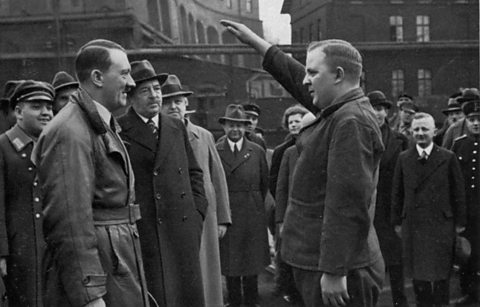
- count5 of 7
